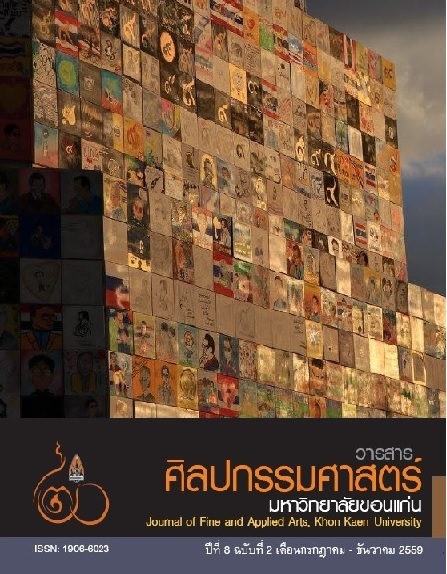การศึกษาเครื่องดนตรีจากคัมภีร์ใบลานมอญ “กฺยาจ เจ นู ฟอ” พระพุทธเจ้าเสด็จลงจากสวรรค์ A study of Mon Musical Instruments from the Palm Leaf scripture “Kyak Che Nu Fo” The Buddha descended from heave
Main Article Content
Abstract
งานวิจัยเรื่องการศึกษาเครื่องดนตรีจากคัมภีร์ใบลานมอญ “กฺยาจ เจ นู ฟอ” พระพุทธเจ้าเสด็จลงจากสวรรค์นี้ มีวัตถุประสงค์เพื่อศึกษาเครื่องดนตรีมอญที่ปรากฏในคัมภีร์และศึกษาบทบาทความสำคัญของเครื่องดนตรีที่ปรากฏในวรรณกรรม โดยศึกษาจากคัมภีร์ใบลานต้นฉบับ จำนวน 3 ผูก และเอกสารที่คัดลอกมาจากคัมภีร์ใบลานต้นฉบับอีก 1 ฉบับ ได้แก่ คัมภีร์ใบลานต้นฉบับจากหอสมุดแห่งชาติ จำนวน 2 ฉบับ คัมภีร์ใบลานต้นฉบับจากวัดสองพี่น้อง อำเภอสามโคก จังหวัดปทุมธานี จำนวน 1 ฉบับ และเอกสารที่คัดลอกมาจากคัมภีร์ใบลานต้นฉบับที่เป็นสำนวนของนายโทวมะเงอ จุลศักราช 1209 ผลการวิจัยพบว่า เอกสารทั้ง 4 ฉบับได้ระบุรายชื่อเครื่องดนตรีมอญหลายชนิด สามารถจัดกลุ่มได้ 4 ประเภท คือ 1) กลุ่มเครื่องหนัง จำนวน 20 ชนิด 2) กลุ่มเครื่องตี จำนวน 7 ชนิด 3) กลุ่มเครื่องเป่า จำนวน 8 ชนิด 4) กลุ่มเครื่องสาย จำนวน 4 ชนิด ในด้านบทบาทความสำคัญของดนตรีที่ปรากฏในวรรณกรรม พบว่า ดนตรีถูกกล่าวถึงในฐานะเป็นเครื่องบูชาของเทวดาบนสวรรค์เพื่อใช้บรรเลงสรรเสริญพระพุทธเจ้า ในประเด็นดังกล่าวได้ปรากฏชัดเจนอยู่ในเอกสารที่เป็นสำนวนของ นายโทวมะเงอ จุลศักราช 1209 โดยการสร้างคำเลียนแบบเสียงของเครื่องดนตรีแต่ละชนิดมาผูก ร้อยเรียงกับคำศัพท์บาลีเพื่อแสดงความหมายสำหรับสรรเสริญพระพุทธเจ้า
The Palm Leaf scripture, referred to as Kayak Che Nu Fo, contains valuable ethnomusicological information on Mon musical instruments. The Buddha descended from heaven. My objectives are to study the Mon musical instruments and the function performed by music in this literature. The documents studied for this research are three original palm leaf scriptures with different styles of composition and a further document which was copied from an original written in the year of Mon Sakkrat 1209. The following results were found regarding musical instrument consisting of 20 membranophones, 7 idiophones, 8 aerophones, and 4 chordophones. The detail given to musical instruments in these texts shows that music was considered a significant part of the worship for Buddha. This is the case in Nai Tho Ma Nger’s version (1209). He composed by using onomatopoeia in that he used Pali words to describe the sound of musical instruments. Therefore the sound of each musical instrument conveys a meaning about the worship.
Article Details
Content and information in articles published in the Journal of Fine and Applied Arts of Khon Kaen University is regarded as the opinion and sole responsibility of the author(s) directly; therefore, editors are not obliged to agree to or share any responsibility with regard to the content and information that appears within these articles.
All articles, information, content, image, etc. that have been published in the Journal of Fine and Applied Arts of Khon Kaen University is the copyright of the Journal of Fine and Appllied Arts of Khon Kaen University. Any person or organization who wishes to distribute all or parts of the articles for further dissemination or other usage must first receive permission from the Journal of Fine and Applied Arts of Khon Kaen University before proceeding to do so.


